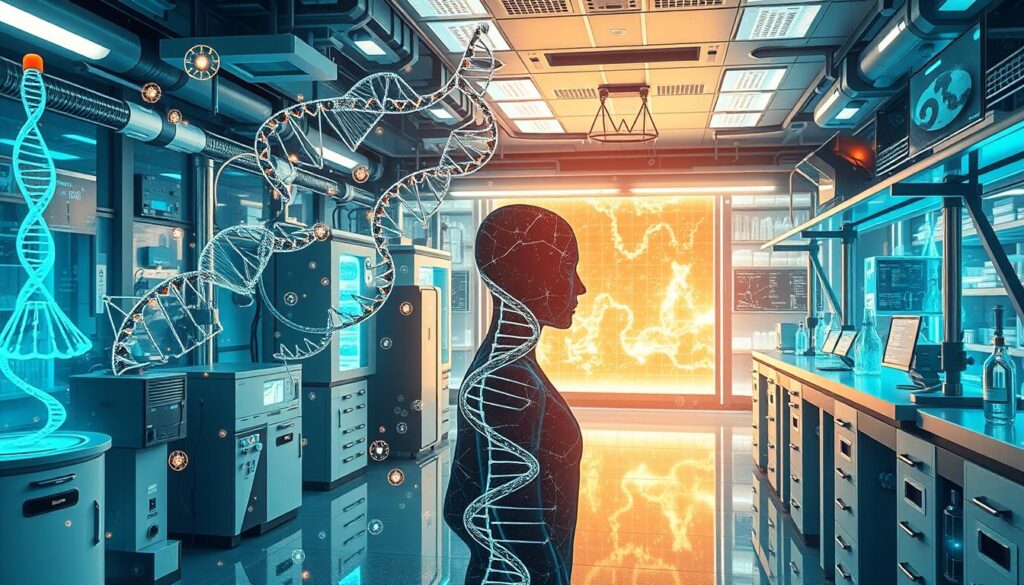In the ever-evolving landscape of scientific advancement, genetic engineering has captured the public’s attention like never before. This field sparks intense debate as we explore the profound possibilities and ethical complexities of manipulating the human genome. It’s essential to examine this topic from multiple angles. In this article, I will delve into the ethical considerations of genetic engineering, highlighting its potential benefits, risks, and societal implications.
Genetic engineering has the power to revolutionize various aspects of our lives, from medical breakthroughs to advancements in agriculture. The rapid development of tools like CRISPR has made precise gene editing increasingly accessible. Yet, this capability also raises significant moral and ethical questions for our society.
This exploration will cover the core debates surrounding genetic engineering. We will examine the principles of bioethics and the diverse perspectives that shape the ongoing discourse. From the potential to cure genetic diseases to the ethical dilemmas of designer babies, we will unpack the complex considerations essential for the future of this field.

Key Takeaways
- The article explores the ethical landscape of genetic engineering, examining its potential benefits, risks, and societal implications.
- It discusses current debates, technological advancements, and the future of human genome modification.
- The article aims to provide a comprehensive understanding of the complex ethical considerations surrounding genetic engineering.
- It will delve into the key debates, principles of bioethics, and diverse perspectives that shape the ongoing discourse.
- The article will unpack the nuanced considerations that are crucial to shaping the future of this transformative field.
Understanding the Fundamentals of Genetic Engineering
Genetic engineering has transformed our grasp of life’s genetic code. Since the 1970s, it has evolved from initial experiments to the advent of CRISPR technology. This field continues to redefine the limits of genetic manipulation.
Basic Principles and Techniques
Genetic engineering revolves around altering DNA, the blueprint of life. Scientists use gene splicing, insertion, and deletion to modify genes. These methods enable the introduction of beneficial traits or the elimination of harmful ones. This opens up vast opportunities in medicine, agriculture, and conservation.
Historical Development of Gene Modification
The journey of gene modification began in the 1970s with the first successful experiments. Since then, the field has advanced significantly. It has evolved from recombinant DNA technology to zinc finger nucleases and, most notably, CRISPR-Cas9.
Key Terminology in Genetic Engineering
- DNA (Deoxyribonucleic Acid): The fundamental genetic material that carries the instructions for the development and function of living organisms.
- Gene: A specific sequence of DNA that encodes the instructions for a particular trait or characteristic.
- CRISPR (Clustered Regularly Interspaced Short Palindromic Repeats): A gene-editing technology that allows for precise and efficient modification of DNA sequences.
- Recombinant DNA: DNA molecules created by combining genetic material from different sources, often used in genetic engineering experiments.
Grasping these concepts is crucial for understanding genetic engineering’s complexities.
Exploring genetic engineering reveals its vast potential to tackle global challenges. It can help cure diseases and improve food production. Yet, we must thoughtfully consider the ethical and societal impacts of these advancements as we move forward.
The Ethics of Genetic Engineering: Core Debates and Considerations
Genetic engineering, promising medical breakthroughs and scientific advancements, sparks intense debate in bioethics. We must confront the deep moral dilemmas it poses, given our ability to alter life’s fundamental building blocks.
Critics worry about “playing God” by altering the human genome. They see it as crossing the line of our role as life’s caretakers, entering divine territory. This argument raises questions about the ethics of our power to shape future generations’ genetic makeup.
The specter of eugenics also looms over genetic engineering. Eugenics’ dark history shows attempts to breed for desired traits. The fear is that genetic engineering could lead to “designer babies,” creating a society with genetic discrimination and social stratification.
- Balancing scientific progress with moral responsibility
- Concerns about the unintended consequences of genetic modifications
- Debates around the line between therapeutic and enhancement interventions
Addressing these bioethics debates and controversies is complex. We must find a balance between the technology’s potential and our moral duties. This includes protecting human life’s sanctity and individual dignity.
| Ethical Concern | Key Considerations |
|---|---|
| Playing God | Philosophical and religious arguments about the boundaries of human intervention in the natural order |
| Eugenics | Fears of genetic discrimination and the creation of a society of “designer babies” |
| Unintended Consequences | Potential for unforeseen and unintended consequences of genetic modifications |
As we tackle these complex moral dilemmas, inclusive dialogues are crucial. We must ensure genetic engineering’s development and use adhere to the highest ethical standards. This way, we can harness its transformative potential while protecting everyone’s rights and dignity.
Benefits and Risks of Human Genome Modification
The field of human genome editing is on the cusp of revolutionizing medical treatments for genetic diseases. By precisely editing DNA sequences, researchers are finding new ways to correct hereditary disorders. This could significantly reduce human suffering. Yet, these advancements also raise significant risks and ethical dilemmas that need careful consideration.
Medical Breakthroughs and Possibilities
Genetic engineering, especially with CRISPR technology, is unlocking new avenues for human genome editing. Scientists are working to treat severe genetic disease treatment like Huntington’s disease and cystic fibrosis. The goal is to directly address these conditions’ root causes, potentially improving patient outcomes and quality of life dramatically.
Potential Dangers and Unintended Consequences
The allure of hereditary modifications for medical benefits is undeniable. However, the risks and unintended effects must be thoroughly assessed. There are concerns about long-term genetic alterations’ effects on individuals and future generations. Such changes could lead to unforeseen health problems or significant impacts on human biology and behavior.
Impact on Future Generations
- Genetic modifications passed down to offspring and future generations could have profound consequences.
- It’s crucial to consider the ethical implications of altering the human genome and its potential effects on genetic diversity and identity.
- Creating robust regulatory frameworks and ethical guidelines is essential for the responsible and equitable use of these technologies.
As human genome editing advances, finding a balance between its benefits and ethical concerns is vital. Ongoing research, open dialogue, and the development of comprehensive policies are key to navigating this complex field.
“The ability to edit the human genome holds both great promise and great peril. We must proceed with the utmost care and diligence to ensure that these technologies are used for the betterment of humanity, not its detriment.”
Religious and Cultural Perspectives on Gene Editing
The rapid progress in genetic engineering has ignited heated debates in both religious and cultural circles. It’s vital to grasp the varied viewpoints on this intricate subject as we explore the new territory of gene editing technology.
Many religious groups have struggled with the idea of humans altering life. The religious views on genetic engineering often revolve around the fear of “playing God” and the sacredness of the human genome. Some faiths see genetic engineering as a breach of divine order, while others believe it’s a way to fulfill humanity’s duty to care for the natural world.
Diverse cultural attitudes towards biotechnology exist globally, influenced by different societies and beliefs. Some cultures welcome gene editing’s potential to solve major health and social issues. Others fear it could undermine cultural identity and traditional values. The dialogue between faith and science shapes public opinion and policy on genetic engineering.
Understanding these varied perspectives requires a deep dive into the beliefs, values, and concerns that underpin them. Through open and respectful dialogue, we can strive for a more inclusive approach to the ethical challenges posed by genetic engineering advancements.

“The ability to modify human genes raises profound questions about the limits of human intervention in the natural world.”
As we delve deeper into the religious views on genetic engineering and cultural attitudes towards biotechnology, it’s crucial to prioritize diverse perspectives. We must ensure that our decisions reflect the complex and multifaceted nature of this issue.
Designer Babies: Drawing the Line in Genetic Enhancement
The concept of “designer babies” has ignited fierce debates, exploring the intricate world of genetic engineering. It challenges the distinction between therapeutic and enhancement modifications. As genetic enhancement progresses, defining the ethical limits becomes more pressing.
Therapeutic vs. Enhancement Modifications
Genetic interventions for serious medical conditions are generally accepted. However, enhancements beyond medical needs cloud the ethical waters. Concerns about fairness and potential consequences of creating a genetically superior class arise.
Parental Rights and Responsibilities
The ethical debate intensifies with parental choice in genetic engineering. Supporters believe parents should decide their children’s genetic fate. Critics fear it could lead to a designer babies ethics crisis, with parents seeking genetic enhancement for non-medical purposes.
Social Justice Implications
The risk of parental choice in gene editing worsening social inequalities is significant. Genetic enhancements might only be accessible to the affluent, widening the social gap. This highlights the need for fair distribution of such groundbreaking technologies.
As genetic engineering’s scientific and technological prowess grows, so will debates on designer babies ethics, genetic enhancement, and parental choice in gene editing. Addressing these complex issues demands a deep understanding of benefits, risks, and societal impacts. This is crucial to ensure these technologies are developed and used ethically.
Legal Framework and Regulatory Challenges
The rapid progress in genetic engineering poses significant challenges for policymakers and regulators. They must adapt to the quick pace of technological advancements. The legal environment for genetic engineering laws and bioethics regulations is intricate. It includes a variety of international gene editing policies, each differing across countries and regions.
One major hurdle is finding the equilibrium between promoting innovation and ensuring public safety and ethical standards. Lawmakers must carefully address complex issues. These include the ethics of human germline modifications and the environmental impacts of releasing genetically modified organisms.
| Country | Regulatory Approach | Key Policies |
|---|---|---|
| United States | Fragmented regulatory framework | Varying regulations across federal agencies No comprehensive law on genetic engineering Reliance on existing laws like the Coordinated Framework for the Regulation of Biotechnology |
| European Union | Centralized, precautionary approach | Strict regulations on genetically modified organisms (GMOs) Emphasis on consumer choice and labeling requirements Ongoing debates on gene editing techniques like CRISPR |
| China | Rapidly evolving regulatory landscape | Emerging policies on gene editing and human embryo research Attempts to balance economic development and ethical concerns Collaboration with international bodies on governance frameworks |
The global scene of genetic engineering laws and bioethics regulations is constantly changing. Policymakers and stakeholders must collaborate to create a unified regulatory framework. This framework should align with scientific progress while upholding ethical principles.
“The regulation of genetic engineering is a matter of global importance, requiring multilateral cooperation and a shared commitment to responsible innovation.”
Environmental Impact of Genetically Modified Organisms
Genetic engineering’s evolution raises concerns about genetically modified organisms (GMOs) environmental impact. Understanding the long-term effects on ecosystems and biodiversity is crucial. These technological advancements’ sustainability is at stake.
Ecosystem Effects
GMOs introduction into natural environments can disrupt ecosystems. Genetically modified plants may outcompete native species, altering the food web. Herbicides and pesticides used with some GMO crops harm beneficial insects and wildlife.
Biodiversity Concerns
- Genetically modified crops’ widespread cultivation reduces genetic diversity. Traditional crop varieties are replaced by a few modified strains.
- The risk of cross-pollination between GMOs and wild counterparts threatens natural gene pools. This could lead to the loss of valuable genetic diversity.
- Unintended GMO effects on non-target species, like pollinators, can harm ecosystem biodiversity.
Sustainability Considerations
Genetic modification technology’s long-term sustainability is a key concern. GMOs may offer short-term benefits like increased yields or pest resistance. However, their long-term environmental and future generation impacts are uncertain. Responsible and sustainable GMO use is vital for our planet’s health and ecosystem preservation.
| Potential Environmental Impacts of GMOs | Mitigation Strategies |
|---|---|
| Ecosystem disruption | Comprehensive risk assessment, responsible deployment, and continuous monitoring |
| Loss of biodiversity | Preserving genetic diversity, regulating gene flow, and supporting sustainable agriculture practices |
| Long-term sustainability concerns | Developing robust regulatory frameworks, fostering interdisciplinary collaboration, and promoting public awareness |
The GMO environmental impact debate is ongoing. Policymakers, scientists, and the public must engage in informed dialogue. Addressing GMO environmental impact, genetic modification and ecosystems, and biodiversity and GMOs issues is essential. This way, we can strive for a sustainable and ecologically resilient future.
Economic Implications of Genetic Engineering Technology
The rapid advancements in genetic engineering technology have profoundly impacted the biotech industry, reshaping the economic landscape. As the genetic engineering market grows, it’s crucial to examine the broader economic implications of this transformative field.
One of the primary economic drivers of genetic engineering is the potential for groundbreaking medical breakthroughs. Gene therapies and personalized medicine promise to revolutionize healthcare, leading to more effective treatments and improved patient outcomes. However, the high costs of gene therapy have raised concerns about accessibility and affordability for patients.
| Metric | Value |
|---|---|
| Global genetic engineering market size (2022) | $28.2 billion |
| Projected CAGR (2023-2030) | 12.9% |
| Average cost of a single gene therapy treatment | $2.1 million |
The biotech industry has seen significant investment in genetic engineering research, driving innovation and advancements. However, the high costs of gene therapy development and regulatory approval processes have posed challenges for smaller biotech companies. This potentially hinders their ability to compete in the genetic engineering market.
As the biotech industry economics continue to evolve, policymakers and healthcare stakeholders face the complex task of balancing the potential benefits of genetic engineering with the need for gene therapy costs that are accessible to the broader population. Innovative financing models, strategic collaborations, and targeted government subsidies may play a crucial role in ensuring that the transformative power of genetic engineering technology is equitably distributed.

“The economic implications of genetic engineering are far-reaching, with the potential to revolutionize healthcare and reshape the competitive landscape of the biotech industry. As we navigate this uncharted territory, it will be vital to strike a balance between fostering innovation and ensuring affordable access to these cutting-edge technologies.”
The Role of CRISPR in Modern Genetic Engineering
The advent of CRISPR gene editing has reshaped the field of genetic engineering. This technology, rooted in the CRISPR-Cas9 system, has unlocked new avenues for scientists. It has transformed the way we approach gene modification.
Technical Applications
CRISPR’s versatility is evident in its diverse applications. It can correct genetic defects and enhance beneficial traits. This technology has been used in CRISPR gene editing and CRISPR-Cas9 applications. It has led to the development of treatments for genetic disorders, marking a significant step towards personalized medicine.
Safety Protocols
Ensuring the gene editing safety of CRISPR is paramount. To address potential risks, strict safety protocols have been put in place. These include thorough testing, stringent regulations, and continuous research. These measures form the backbone of CRISPR’s safety framework.
Future Developments
The future of genetic engineering looks promising with CRISPR at its core. Researchers are exploring new uses, like boosting crop yields and fighting infectious diseases. CRISPR’s potential to transform our lives is vast, and the coming years will see significant progress in this field.
“CRISPR has the potential to revolutionize our approach to genetic engineering, unlocking new avenues for scientific discovery and practical applications.”
As scientists refine CRISPR’s capabilities, its impact on genetic engineering will expand. This will lead to groundbreaking advancements, promising a brighter future.
Public Perception and Social Acceptance
Genetic engineering and biotechnology are advancing rapidly. Understanding public perception and acceptance is now more critical than ever. The public’s view on genetic engineering is complex, influenced by scientific knowledge, cultural beliefs, and concerns about risks and benefits.
The level of gene editing awareness greatly impacts biotechnology acceptance. Research indicates that those who understand genetic engineering better tend to see its benefits. These include medical advancements and improved crop production. Yet, ethical concerns, safety, and long-term effects also shape public opinion.
| Factor | Impact on Public Perception |
|---|---|
| Scientific Literacy | Higher understanding leads to greater acceptance |
| Cultural and Religious Beliefs | Can influence concerns about the ethical implications |
| Perceived Risks and Benefits | Balancing potential advantages and drawbacks shapes overall opinion |
| Media Portrayal | Positive or negative media coverage can impact public perception |
Effective science communication is key to shaping public views on genetic engineering. By providing clear, accessible information and addressing concerns, experts can foster a more informed public. This can lead to greater acceptance of these emerging technologies.
“The public’s acceptance of genetic engineering will be critical in determining the future direction and pace of scientific progress in this field.” – Dr. Emily Walters, Bioethicist
As genetic engineering evolves, monitoring public opinion is essential. It ensures that technological advancements align with societal values and concerns.

Ethical Guidelines for Research and Implementation
Genetic engineering’s rapid progress demands strict ethical guidelines for its responsible use. These standards must uphold professional integrity, ensure informed consent, and enforce strict quality control. This approach is vital for the field’s future.
Professional Standards
Researchers and practitioners in genetic engineering must follow the highest ethical standards. They should align with the principles and guidelines of leading bioethics organizations. This commitment includes transparency, objectivity, and prioritizing the well-being of participants and the community.
Informed Consent Requirements
Informed consent is a cornerstone of ethical genetic engineering research. Participants must receive detailed information about the potential risks and benefits of genetic modifications. This ensures they understand and consent voluntarily. It’s also crucial to allow for ongoing monitoring and the option to withdraw consent.
Quality Control Measures
Implementing stringent quality control measures is essential to manage risks and unintended consequences in genetic engineering. Safety protocols, rigorous testing, and thorough oversight are necessary. These steps help maintain the integrity of research and development.
FAQ
What is genetic engineering and how does it work?
Genetic engineering involves altering an organism’s DNA to introduce, remove, or change specific traits. It employs techniques like gene insertion, editing, and sequencing to modify genetic makeup. This process allows for precise changes in an organism’s DNA.
What are the potential benefits of genetic engineering?
Genetic engineering could lead to significant medical advancements. It may treat genetic diseases, enhance disease resistance, and create personalized therapies. Additionally, it promises to improve agriculture, environmental conservation, and industrial processes.
What are the ethical concerns surrounding genetic engineering?
Ethical debates center on concerns like playing God, misuse, and eugenics. There’s also worry about its impact on future generations and the balance between scientific progress and moral responsibility.
How does CRISPR technology work, and what is its role in modern genetic engineering?
CRISPR is a gene-editing tool that enables precise DNA sequence modification. It’s efficient, cost-effective, and has revolutionized genetic engineering. This technology is crucial in research, medicine, and agriculture, opening up new possibilities.
What are the regulatory and legal challenges in the field of genetic engineering?
The rapid pace of genetic engineering technology poses challenges for policymakers and regulatory bodies. They must establish legal frameworks, safety protocols, and oversight to ensure responsible use of these technologies.
How do different religious and cultural perspectives view the ethics of genetic engineering?
Religious and cultural views on genetic engineering vary widely. Some see it as a violation of divine will, while others view it as a way to alleviate suffering. Understanding these diverse perspectives is key to navigating the complex ethics of genetic engineering.
What are the potential environmental impacts of genetically modified organisms (GMOs)?
GMOs raise concerns about ecosystem effects, biodiversity loss, and sustainability. It’s essential to assess and monitor their ecological impact to mitigate unintended consequences.
How do economic factors influence the development and accessibility of genetic engineering technologies?
Economic factors, such as market trends and investment in biotech research, impact genetic engineering. They also influence healthcare costs and accessibility. Understanding these factors is crucial for ensuring equitable distribution of benefits and risks.
What are the ethical guidelines and best practices for genetic engineering research and implementation?
Ethical guidelines for genetic engineering include professional standards, informed consent, quality control, and ongoing impact assessments. Adhering to these guidelines is vital for responsible advancement in genetic engineering.










